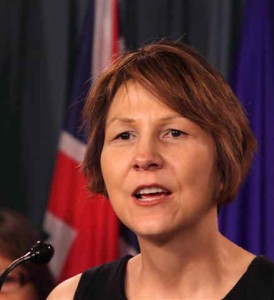Building two bridges: Speech by Dr. Cindy Blackstock
Dr. Cindy Blackstock is the Director of The First Nations Child and Family Caring Society. She gave this speech at a national event in support of the UN Declaration on the Rights of Indigenous Peoples. KAIROS , over 20 national organizations, and dozens of communities across the country contributed to this event, which celebrated the Declaration and Canada’s endorsement of it- and called on Canada to put it into action as one vital part of a common commitment to justice, reconciliation, and right relations. The Declaration is one step on the path to reconciliation. Equitable funding for all of Canada’s children is another.
Cindy Blackstock’s speech at KAIROS’ Roll with the Declaration event at the Human Rights Monument, Ottawa, June 20, 2011
Canada builds two bridges for children over the turbulent waters of life’s hazards. One is for non-Aboriginal children (which could be much stronger for a wealthy nation) and thankfully most children make it to the other side. Then there is the half a bridge that Canada builds for First Nations children.
When First Nations and their many non-Aboriginal allies call out for help as children struggle, the Government of Canada asks why we are not thankful for the half a bridge they built for us. As the Auditor General, the Standing Committee on Public Accounts, and the Government’s own documents reveal, child welfare, education and other essential services for children on reserves are funded in flawed and inequitable ways. The results for children are devastating.
First Nations children get less funding for child welfare, creating what the government’s own documents call a “dire” situation as inadequate prevention services drive countless children unnecessarily into foster care. In 2007, the Assembly of First Nations and the First Nations Child and Family Caring Society filed a historic human rights complaint against Canada alleging that its flawed and inequitable child welfare funding amounted to racial discrimination against First Nations children (www.fnwitness.ca). Canada has not defended this case on the merits; rather, it has employed residential school lawyers to try to derail the hearing on legal technicalities.
Many First Nations children are denied government services available to all other children because the Federal Government and Provincial/territorial governments fight over who should pay for services. Jordan River Anderson spent over 2 years unnecessarily in hospital as governments fought over payment for his at home care before he died at the age of 5. Jordan’s Principle, a child-first principle to resolving these disputes, is named in his honour. Parliament unanimously supported Jordan’s Principle (www.jordansprinciple.ca) in 2007 and then tragically, and distastefully, Canada tried to narrow it to apply only in a handful of cases.
First Nations children also get shortchanged in education. Every First Nations student gets $2000 to $3000 less per year for education funding, meaning fewer books, no libraries, no computers and very few science labs or learning supports for learners with different needs. Many First Nations children have to leave home at a young age to go to school hundreds of kilometers away and others go to schools in terrible conditions that include rat, snake and mold infestations. These horrible conditions contribute to less than half of First Nations children graduating from high school.
Shannen Koostachin of Attawapiskat First Nation went to school in broken down portable trailers next to a contaminated waste dump. She advocated her entire life for culturally based equity in education before tragically passing away last spring in a car accident at the age of 15. Children who were inspired by her created the Shannen’s Dream Campaign (www.shannensdream.ca) to ensure safe and comfy schools and equitable education.
Racial discrimination against children should not be viewed as a legitimate fiscal restraint measure by any Canadian Government. It is time for Canada to finish the bridge for First Nations children and breathe life into the United Nations Declaration on the Rights of Indigenous Peoples.









